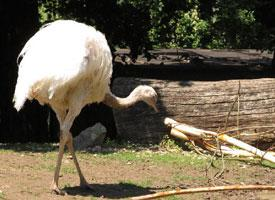
Greutăți și măsuri
| Înălțime la greabăn | de la 120 la 150 cm |
|---|---|
| Greutate | 20 kg |
Date biologice
| Durata de viață | 15 r |
|---|
Descrierea animalului
The Greater Rhea (Rhea americana) is a large, flightless bird native to South America, notably found in countries such as Brazil, Argentina, Paraguay, and Uruguay. This remarkable species is the largest bird in the Americas, standing at an impressive height of up to 1.5 meters (almost 5 feet) and weighing as much as 40 kilograms (about 88 pounds). With its long, powerful legs and large, three-toed feet, the Greater Rhea is well adapted to its terrestrial lifestyle, capable of running at speeds of up to 60 kilometers per hour (about 37 miles per hour) to escape predators or to cover large distances in search of food.The physical appearance of the Greater Rhea is notable for its large, fluffy, grey-brown feathers, which cover its body except for the head and neck, which are sparsely feathered. The male and female are similar in appearance, though males tend to be slightly larger. One of the most distinctive features of the Greater Rhea is its wings. Despite being flightless, these birds possess large wings relative to their body size, which they spread out while running to help maintain balance or change direction quickly. Additionally, during the breeding season, males use their impressive wings as part of their courtship display to attract females.
Greater Rheas are omnivorous, feeding on a wide variety of plant material such as leaves, seeds, and fruits, as well as insects, small vertebrates, and even carrion when available. This dietary flexibility helps them thrive in diverse habitats, ranging from open grasslands to savannas and scrub forests.
Social behavior is a fascinating aspect of the Greater Rhea's life. They are often seen in small flocks, which can consist of both genders and various ages. However, during the breeding season, the social structure shifts dramatically. The males become polygamous, establishing territories and attracting multiple females to lay eggs in a nest that the male has prepared. Remarkably, it is the male who takes on the responsibility of incubating the eggs, a task he performs with great diligence, and later, he is the primary caregiver of the chicks until they are independent. This role reversal is quite unique among birds and highlights the complex social behavior of the species.
The conservation status of the Greater Rhea is currently listed as Near Threatened by the International Union for Conservation of Nature (IUCN). Habitat loss due to agricultural expansion, hunting for meat and feathers, and egg collection have significantly impacted their populations. Efforts are being made to protect this species, including habitat conservation, legal protection, and breeding programs in some areas.
In summary, the Greater Rhea is a captivating and unique bird that plays a significant role in the ecosystems of South America. Its impressive size, distinctive appearance, and intriguing behaviors, combined with its importance in cultural and economic contexts, make it a fascinating subject of study and conservation efforts.
Fotografii noi cu animale
Top 10 animale
- Dolphin gull (Leucophaeus scoresbii)
- Diana monkey (Cercopithecus diana)
- Moustached guenon (Cercopithecus cephus)
- Galápagos tortoise (Geochelone nigra complex)
- Stone loach (Barbatula barbatula)
- Japanese macaque (Macaca fuscata)
- Greek tortoise (Testudo graeca)
- Russian tortoise (Testudo horsfieldii)
- Common flying dragon (Draco volans)
- Galápagos penguin (Spheniscus mendiculus)